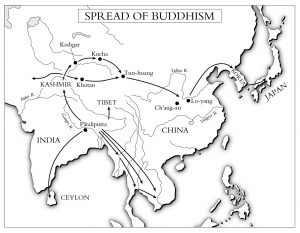18 Introduction of Buddhism into China
Dean Schweinler
Introduction Of Buddhism Into China
Before diving into how Buddhism affects the thoughts and beliefs of the people in Early China, it would be best to explain how Buddhism made its way into China. The spread of Buddhism into China is shrouded in mystery as the date it entered China remains unknown. Erik Zürcher, a Dutch scholar who specialized in Buddhism, Sinology, and Chinese religions, best described the issues with pinpointing the exact date or year Buddhism entered China.
“[Few] passages about Buddhism which occur in early Chinese historical works are, so to speak, casual remarks made by the historiographer in the course of his narrative. Apart from a few phrases in the Hou-Han ji, a fourth century history of the Later Han dynasty, none of these passages were written or included with the intention of saying something about Buddhism itself,”[1]

Zürcher pinpoints the difficulty of finding information relevant to dating the entry of Buddhism into China. Discovering mention of Buddhism in the Hou-Han shu is important for understanding just how long Buddhism has influenced Chinese culture. It is very likely that Buddhism arrived through trade routes. On the western side of the continent, the Romans created bulk commodity trade by ship in the second century CE, and a similar development may have taken place in South and East Asia. Trade routes by sea made the transportation of goods for trading much faster and safer than overland. Buddhism likely spread to China between the second and first century CE. Along with the spread of Buddhism in China came many ideas and inventions related to the ancient religion.

Legends make many claims as to when Buddhism arrived into China. Kenneth Ch’en argues, “these accounts concerning the introduction [of Buddhism to China] are legendary or unreliable or are due to the religious zeal of Buddhist writers,”[2]
When one hears the term “Buddhism”, they tend to associate it with enlightenment, non-violent monks, karma, and reincarnation.[3] Due to karma and belief in reincarnation, early Chinese Buddhists believed in an afterlife that enforced ramifications for those who acted sinfully during their time on Earth. Every person was judged on their time on Earth and their actions corresponded with what their path in the afterlife would be.
Prior to the arrival of Buddhism in China, the common view of the afterlife was quite morbid as wealth, family, and status were the most important factors when establishing one’s path in the afterlife. Simply, the wealthy were comfortable in both life and the afterlife while the poor remained uncomfortable for eternity. The arrival of Buddhism drastically altered this mindset as the dead were no longer being judged on their wealth: karma was now the major factor that determined one’s path in the afterlife. This new view of the afterlife was a drastic change from the two major Chinese religions at the time, Confucianism and Taoism. Buddhism changed how ancestors were viewed and the requirements of their descendents. This directly affected early Chinese culture as Buddhism rose to popularity. The fear of going to Buddhist hell was likely a terrifying one because unlike in Christianity one was unable to be forgiven for their sins. The specific details of Buddhist hell have been illustrated through historic texts, as well as pieces of art, and you can read more in the previous chapter. Some of the literature that describes these images of Buddhist hell are stories of those who have traveled through it and returned to tell the tale to the living.

The Buddhists’ beliefs in the afterlife was not the only thing Buddhism impacted in China. The largest impact Buddhism had on China was literature and language. For nearly 1000 years, since the entry of Buddhism into China, Chineses buddhists translated Buddhists scriptures into Chinese. This was very important because the ideas and beliefs of the Buddhists could be read by and taught to anyone who could read Chinese. New theories and ideas meant new words for the Chinese Buddhist translators and many of those new words have been incorporated into the Chinese language, paving way for a new types of Chinese literature such as novels, religious literature, and song lyrics.[4]
